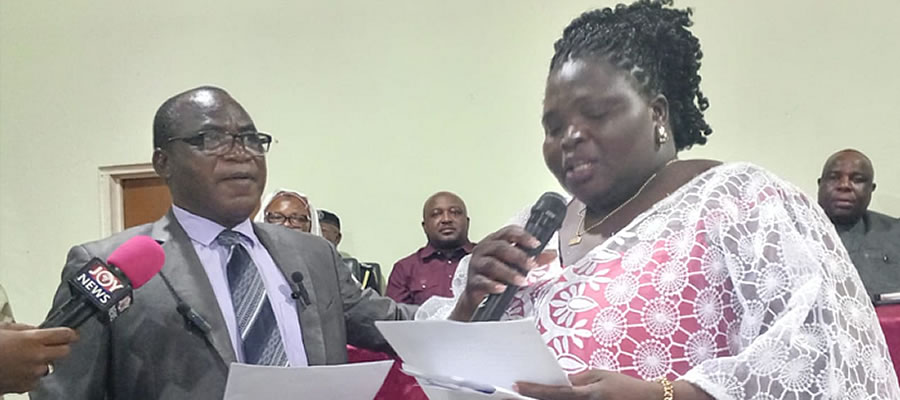

A strong micro-district economy is very vital in the reduction of extreme poverty. Thus a better understanding of the characteristics of the district economy in terms of the advantages it offers for poverty reduction is critical for analysis. This section is thus concerned with the structure of the district’s economy, household income and expenditure pattern and the Assembly’s revenue and expenditure pattern.
Structure of the Economy
Being a typical rural district, the economy of Nadowli is dominated by the agriculture sector with the commerce and industrial sectors-least developed. Agriculture alone accounts for about 85% of the labour force while commerce/service and industry account for 14% and 1% of the labour force respectively.
Household Income
The mean annual household income of the district is 0 4,800,382 giving an average monthly household income of 0400,03 1. The major source of income to households in the district is agriculture. It accounts for 48.9 percent of the total annual income of the district. Commerce accounts for 35.5 percent and this is followed by service 15 percent. Industry accounts for just 0.6 percent.
This indicates the dominance of the agricultural sector in terms of income generation to households in the district. Thus, there is the need for investments that will ensure the necessary backward and forward linkages between agriculture, and the other sectors of the economy. This if achieved, will ensure better prices for farmers and also bring about the diversification of the local economy.
Expenditure
The mean annual household expenditure for the district is estimated to be 05,040,000 giving an average monthly household expenditure of ¢420,000.This shows a gap between household expenditure and income. The gap is filled by remittances from family members and friends. This situation implies that it will be extremely difficult for households to effectively make financial contributions towards development projects and also expand their businesses.
The main areas of expenditure of the district can be conveniently grouped into capital and recurrent. The capital expenditure of the district includes ail social and economic investments while the recurrent expenditure entails expenditure made for the smooth running of the district administration.
Income Distribution
The Lorenz curve that plots a cumulative percentage of population ranked from the lowest to highest in terms of income against their cumulative share of total income was used to show the distribution of income in the district.
The degree of income inequality is measured by the divergence of the curve from the 45 line-the line of equal distribution. The Gini Concentration Ratio measures this inequality. The Gini Concentration Ratio calculated for the district is 0.46. This implies that there is unequal distribution of income among the residents of the district although the degree of skewness is very low.
The reasons for the inequality is due to the fact that a few of the residence who are employed in the formal and commerce sectors earn better incomes than the majority employed in the agricultural sector.
For instance, whiles workers in the formal public service and the commerce sectors earn average monthly incomes of ¢607000 and ¢480000 respectively, those in the agriculture sector take only ¢81500. Measures should therefore be taken to ensure that incomes of farmers are improved through better storage and marketing of agricultural produce as well as the introduction of other income generating activities in more deprived areas.
District’s Revenue and Expenditure Pattern
This section gives an analysis of the district administration capacity in generating revenue to finance development projects. It also looks at the expenditure pattern of the district in relation to its revenue generation through a time service analysis; It finally examines the existing revenue collection system of the district and its problems.
Sources of Revenue
Revenue to the district is generated from both internal and external sources. The internally generated revenue comes from sources such as rent, land, fees/Hues, licenses and investments. On the other hand the DACF, ceded revenue and donor funds constitute the main source of external revenue.
Revenue Mobilization
Revenue mobilization in the district is done through the use of commission collectors, revenue tax forces and Unit Committees. As observed earlier the district depends heavily on external revenue to nuance most of its development projects.
This problem is traceable to a plethora of problems facing the revenue collection unit of the district. Problems such as the lack of logistics for revenue collectors; inadequate civic awareness on tax obligation; public abuse and humiliation of tax collectors; tax evasion; inadequate tax collectors and limited number of revenue sources have contributed in no small measure to the abysmal local revenue mobilization of the district.
Tin’s further brings to light the need for the capacity of (he revenue collection unit of the district to be strengthened in terms of logistics and personnel to enable it to perform its avowed functions effectively.
Revenue exchange Machine
The revenue expenditure matching of the district has been analyzed to ascertain whether the District Assembly has (lie capacity of generating revenue to finance development projects. This is also to give information about the surplus made or the deficits incurred by the district.
Investment And Business Potential
The economic base of the Nadowli District is agriculture. The relatively low population density per square kilometre makes it possible for any interested investor to have access to large tracts of land for farming. The main crops cultivated are cowpeas, groundnuts, millet, guinea corn, maize, rice and yam.
Cash crops such as cotton and sheanut trees also abound in the district. Cashew, cultivated on a limited scale, is being encouraged as an export crop. Indeed, the District Assembly, is actively promoting private investment in non-traditional export of agricultural and forestry products.
It is estimated that the total arable land is 2,250 square kilometres and the District Assembly is encouraging investors and farmers alike to cultivate sheanut trees and cotton, on a commercial basis, possibly through co-operative ventures.
To boost agricultural development, the District Assembly has put in place a number of agricultural schemes funded by NGOs and other organist ions. Two programmes, the Low Risk Technology in Agriculture Projects (LORITAP) and the International Fund for Agricutlrual Development (IFAD) provide technical assistance to farmers.
Fishing is done along the banks of the Black Volta and Charikpong. The Black Volta and its tributaries are the major fish producing areas in the district. At present, there are about 50 fishermen who fish along the banks of the Black Volta.
To access fish all year round, the fishermen would have to be encouraged to develop fishponds, and apply preservation and processing techniques as a means of adding value to their produce. Animal rearing, notably, cattle, sheep, goats and poultry are important. Generally, however, the people of Nadowli District do not practice mixed farming.
The district has a high potential for the development of plantation agriculture. The annual output of cowpeas in the district is the highest in the country. Dams at Sankana and Daffiama could also be developed to support rice farming. There are also large tracts of undeveloped grey earth and tropical black soils, which can support the production of rice, yam, maize and vegetables under traditional farming systems.
With modern agricultural techniques, these areas can support large-scale farming. It has been established that clay and gold deposits exist in quantities that can support commercial exploitation. Nadowli District Assembly is interested in attracting investors in this area, with a view to developing a local mining industry. Ashanti AGEM Alliance, a mining company, is already prospecting for gold at Charikpong.
There is potential for bricks and tile factory. As such, a factory could use the extensive clay deposits at Charikpong, Nawule and Dauri, which are currently used on a small-scale for pottery. Activities of small-scale industries are at a basic stage and are based on available raw materials.
These include cotton spinning for the manufacture of smocks and cloths, leather works blacksmithing, pito brewing an Shea butter extraction. Nadowli District has vast resources to be tapped and has therefore embarked on an investment promotion programme to attract investors.
The district has opened its doors to investors willing to engage in beneficial projects and offers exemptions from payment of property tax and other local taxes for the first five years of operation. The district will also facilitate the provision of utility services and other infrastructure to industrial sites.
Date Created : 11/16/2017 1:56:17 AM












 facebook
facebook
 twitter
twitter
 Youtube
Youtube
 +233 593 831 280
+233 593 831 280 0800 430 430
0800 430 430 GPS: GE-231-4383
GPS: GE-231-4383 info@ghanadistricts.com
info@ghanadistricts.com Box GP1044, Accra, Ghana
Box GP1044, Accra, Ghana